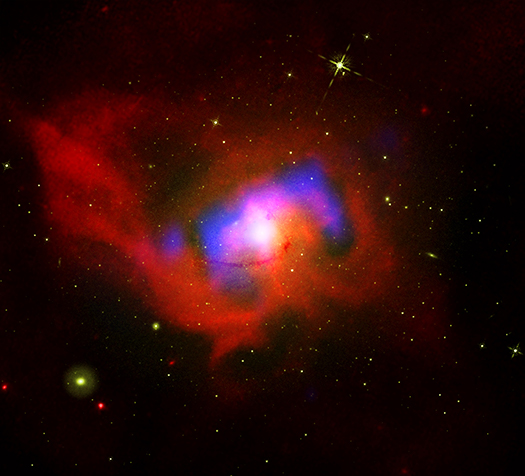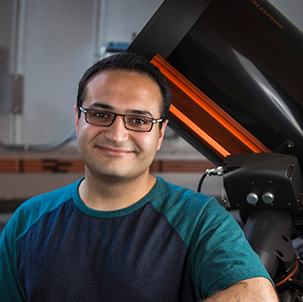The Arrhythmic Beating of a Black Hole Heart

NGC 4696
At the center of the Centaurus galaxy cluster, there is a large elliptical galaxy called NGC 4696. Deeper still, there is a supermassive black hole buried within the core of this galaxy.
New data from NASA's Chandra X-ray Observatory and other telescopes has revealed details about this giant black hole, located some 145 million light years from Earth. Although the black hole itself is undetected, astronomers are learning about the impact it has on the galaxy it inhabits and the larger cluster around it.
In some ways, this black hole resembles a beating heart that pumps blood outward into the body via the arteries. Likewise, a black hole can inject material and energy into its host galaxy and beyond.
By examining the details of the X-ray data from Chandra, scientists have found evidence for repeated bursts of energetic particles in jets generated by the supermassive black hole at the center of NGC 4696. These bursts create vast cavities in the hot gas that fills the space between the galaxies in the cluster. The bursts also create shock waves, akin to sonic booms produced by high-speed airplanes, which travel tens of thousands of light years across the cluster.
Pathways to the Stars -- I

Illustration: NASA/CXC/K.DiVona
(A continuing series on how astrophysicists’ varied career paths. Pathways to the Stars -- II)
Our blogger today is Dr. Wallace Tucker, who has worked on the Chandra project since its inception and has been involved with high-energy astrophysics for several decades. In one of his many roles, Wallace has served as the Chandra Science Spokesperson, helping non-experts understand and enjoy the amazing discoveries Chandra makes. He is the author of several popular books including one published by Smithsonian Books.
How did you get to be an astrophysicist working with the Chandra X-ray Observatory?
This is a question that almost all of us who work with Chandra get asked at one point or another. Apart from cocktail party conversation — not that astrophysicists go to that many cocktail parties, in my experience — the answer is relevant in terms of ongoing efforts to increase the number of young people seeking careers in science, technology, engineering and mathematics.
And, on the principle that "none of us is as smart as all of us," it is important for maximizing the scientific return of Chandra to get as many people involved as possible. Think about it: some of the bright young minds working on Chandra data today were in elementary school when Chandra was launched!
400 Students, Educators, and Technology Professionals Attend "Hidden Figures" Event

Photo Credit: Tracy Karin Prell
Over 400 female middle and high school students, educators, and technology professionals attended a viewing of Hidden Figures and panel discussion at the Warwick Showcase Cinemas on Friday, March 24, 2017. The event was presented by Tech Collective, Rhode Island's industry association for technology, in partnership with NASA's Chandray X-ray Observatory and Providence P-TECH industry partners. The event included a private screening of the 2017 Oscar winning movie followed by a panel discussion featuring female STEAM professionals in Rhode Island.
A Serendipitous Discovery May Provide Our First View of a New Population of X-ray Transients

Franz E. Bauer
It is a pleasure to welcome Franz E. Bauer as a guest blogger. Franz led the study that is the subject of our latest press release. He is an associate professor at Pontificia Universidad Catolica de Chile in Santiago, Chile, where his group studies the cosmic evolution of star-forming galaxies and supermassive black holes, as well as a variety of transient phenomena. He completed his PhD at the University of Virginia in 2001, then worked at Pennsylvania State University, University of Cambridge (UK), and Columbia University before finally moving to Chile.
Like many discoveries in astrophysics, the subject of our recent study was an act of serendipity. Our large international collaboration had been allocated a series of long observations with Chandra to push the exposure from 45 days to 75 days for the deepest X-ray image on the sky to date, the Chandra Deep Field-South (CDF-S). The primary goal of this project was to explore the poorly understood realm of the ultra-faint X-ray universe, to learn how supermassive black holes form in the early Universe and by what mechanisms they grow to become the present day "monsters" that we see today (for details, see a January 2017 press release led by Bin Luo from Nanjing University and Fabio Vito from Penn State University and an associated blog post by Fabio Vito). However, the leaders of this project, colleagues Drs. Niel Brandt (Penn State University) and Bin Luo, had studied variability from known X-ray objects in the previous data containing 45 days of exposure, and were thus monitoring the individual observations as they arrived to check for large deviations.
To our surprise, during one 13-hour observation on October 1st, 2014, a bright, new source emerged (see Figure 1), at a location where no source had been detected, even when summing up all of the previous exposures together. Two days later, in the next Chandra observation, it was gone! We had never anticipated that our observations would capture such a rare, fast transient. After convincing ourselves that it was not some weird instrumental effect, we reported it to the astronomy community as Luo, Brandt & Bauer (2014) in ATEL 6541, to encourage follow-up observations at other wavelengths and gain more clues as to the origin of this unique event.
A White Dwarf and a Black Hole in a Tight Orbit

Dr. Arash Bahramian
We are very happy to welcome Dr. Arash Bahramian as our guest blogger. Dr. Bahramian completed his graduate studies at University of Alberta, Canada with Dr. Craig Heinke on X-ray binaries in globular clusters. After defending his PhD in 2016, he moved to Michigan State University to work with Dr. Jay Strader on study of black holes in globular clusters. He is the first author of the paper featured in our most recent press release.
Stellar mass black holes are formed by the deaths of massive stars. Like other black holes, these objects do not emit any light of their own, and astronomers try to identify them from their interactions with their environment. For example, in a close binary with another star, the black hole's strong gravity pulls material from the companion star. This material falls towards the black hole through a disk called an accretion disk. The massive release of energy due to infall of matter towards the black hole plus friction between particles in the disk, makes this disk extremely hot (about a million degrees Kelvin, roughly 200 times hotter than the surface of the Sun). This temperature is high enough to make the disk bright in X-rays, and so X-ray observatories like NASA's Chandra X-ray Observatory have been used to identify and study these systems.
Over the last few decades, dozens of stellar mass black holes (and black hole candidates) in close binaries with another star have been identified throughout our Galaxy. However, none of these black holes were found in old dense stellar clusters known as globular clusters. This was surprising at first, as we would expect a lot of black holes (maybe around 1000 of them) in these clusters, because many massive stars should have turned into black holes. Furthermore, a crowded stellar environment like a cluster makes interactions between black holes and other stars more likely. For a long time, this absence of black holes in dense stellar clusters was thought to be a result of black holes getting kicked out of the cluster, due to their strong gravity and rapid movement after interacting with other stars and other black holes in the cluster.
From Art to Astrophysics – and Back Again

Melissa Weiss Walter (Photo: Brin Deuk Morris)
We are thrilled to welcome Melissa Weiss Walter as a guest blogger. As Mel describes below, she served as the graphic designer, illustrator and social media developer for Chandra's publicity and outreach efforts for many years. Recently, she has scaled back her Chandra time to focus on her personal artistic endeavors. Thankfully, she remains part of the Chandra family and continues to contribute to Chandra releases.
I have been working with the Chandra team in various capacities for close to two decades. I began creating illustrations of black holes after graduating from the University of Rhode Island. Soon after Chandra launched, I was brought on board to continue as their science illustrator and also as their graphic designer. When MySpace took off like a rocket and we realized that social media was here to stay, I also took on the role as a social media administrator.
In 2015, after working with the team full-time for fourteen years, I made the decision to take a step back. I was able to continue just with my duties in science illustration so that I could pursue a career in fine art. Though I may have discontinued my time with Chandra on a full-time basis, I took with me the inspiration of many years looking at the wonders of our Universe through Chandra's eyes.
Before making the change, I had always loved the work I did with the Chandra team. However, I was so busy creating materials that I didn't have a lot of time to reflect on the content I was using. I knew what we did was important but I never realized how influenced I was becoming by the wonders we communicated with the public on a daily basis.
Visualizing Supernova 1987A in Three Dimensions

Salvatore Orlando
Our latest press release features work by Salvatore Orlando, an astrophysicist working at the INAF-Osservatorio Astronomico di Palermo in Italy. Salvatore and his colleagues have developed the first three-dimensional model of the famous object Supernova 1987A that links the supernova to its remnant, an accomplishment that will help scientists and the public explore this important stellar object like never before. We are very pleased to share answers that Salvatore has provided to our questions about his 3D modeling.
Salvatore graduated in physics from the University of Palermo and completed his PhD at the same university. During his PhD he spent part of this time at the Dept. of Astronomy and Astrophysics at the University of Chicago. Prior to his current position, he was a research fellow for two years at the European Space Agency (ESA), Space Science Dept. (Noordwijk, The Netherlands). His main research activity has been performed in the realm of optically thin astrophysical plasmas (more specifically solar and stellar coronae, supernova remnants) and in the field of thermal and non-thermal (synchrotron) emission processes.
Black Holes and Vacuum Cleaners: Using Metaphors to Explain Space Images
Scientific imagery, especially those from space, can be both powerful and beautiful. The images created by professional and amateur astronomers alike are often striking. This gives science communicators an opportunity to use such images as an access point for the related subject matter. In other words, scientific images are a door through which we can walk towards the discoveries and insight that science can achieve.
The Aesthetics & Astronomy project (A&A) is a unique research project that aims to study exactly how people from different backgrounds and educational experiences interpret and interact with scientific imagery. Started at the Chandra X-ray Center and combining the expertise of astrophysicists, psychologists, image producers, and educators specializing in research methodology, A&A delves into how these images can be used as a vehicle for scientific information.
One question that A&A recently asked is: how effective are metaphors in communicating scientific results? To explore this question, the A&A project solicited input from nearly 2,000 participants and asked a series of questions through an online study. After presenting participants with four astronomical images — Sagittarius A*, Our Sun (solar flare), Cassiopeia A, and the Pinwheel Galaxy — they were shown three separate labels for each.
The Poetry of a Clandestine Black Hole
Over several years we have hosted the results of poetry competitions organised and judged by Jonathan Taylor, a Senior Lecturer in Creative Writing at The University of Leicester in the UK. Here, Jonathan gives some details about the latest competition and discusses the link between poetry and science.
Carnival of Space
It’s Carnival time, folks, so let’s get started! Here is a brief look at interesting space stories from the past week.
At Universe Today, their writers have got the Universe covered. In one post, they take a look at an intriguing new result that may help tie "Joshua's Eclipse" to the Battle of Gibeon, showing how astronomy can help make connections in other fields such as history. https://www.universetoday.com/133166/ancient-annular-dating-joshuas-eclipse/

Processed image taken on Dec. 11, 2016, at 9:27 a.m. PST (12:27 p.m. EST) by the NASA Juno spacecraft, as it performed its third close flyby of Jupiter. Credits: NASA/JPL-Caltech/SwRI/MSSS/Eric Jorgensen
In another post, they explain the most recent exciting pass of the Juno spacecraft over the cloud tops of Jupiter. NASA is also offering the public the chance to vote on what features Juno should image next. Take a look! https://www.universetoday.com/133215/juno-buzzes-jupiter-cloud-tops/
